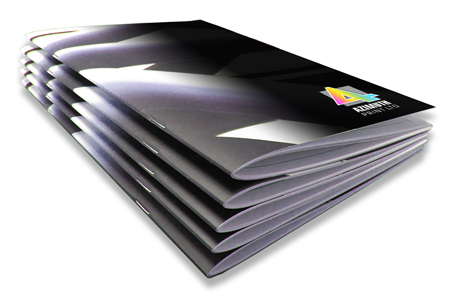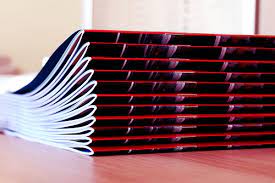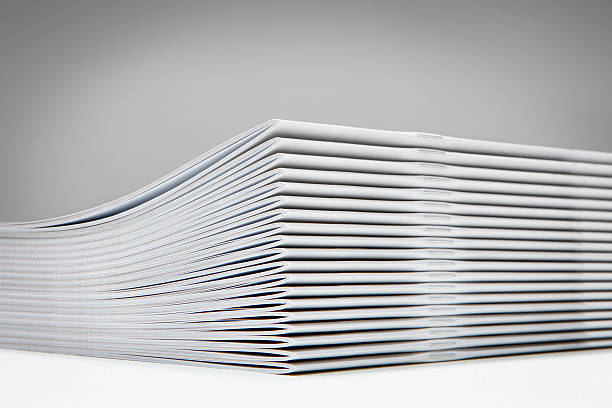
Choosing the right binding technique for print booklets, brochures, and catalogues is paramount. MVP Print excels in this area, particularly with stitch booklets. This method provides a tactile experience that harmonises with the digital age. It has evolved, embracing sustainability and technological progress.
Even with the digital surge, the saddle stitch booklet retains its significance in marketing, education, and creative fields. Their compact, self-contained nature, coupled with customisable elements like artwork and promotional inserts, elevates the professional look of any brand or project.
Introduction to Stitch Booklets
Stitch booklets, commonly referred to as saddle stitched booklets, represent a cost-efficient and versatile printing option across various applications. This method entails folding paper in half and stapling along the crease, creating a booklet that lies flat when opened. Such a binding technique ensures a professional appearance. It is crucial to ensure the correct booklet artwork setup to maintain the right page order and correspondence to the PDF document.
Defining Saddle Stitch Booklets
These booklets can span from 4 to 100 pages, catering to diverse needs from businesses to promotional events and marketing strategies. When creating a booklet, selecting the specific inner pages is crucial for organizing content effectively. Typically, they measure 297mm h x 210mm w, offering a budget-friendly option with a swift production time of about 45 minutes.
The Saddle Stitching Process
- The process begins with 12 single sheets of 100gsm text weight paper, cut to 297mm h x 420mm w, and a single sheet of 250gsm card stock, also cut to 297mm h x 420mm w, for the cover.
- Pages are then folded in half and secured with 6 sewing stations, ensuring a robust binding ideal for frequently handled booklets.
- The tutorial provides detailed instructions on preparing the pamphlet, folding, creating a template, and employing the chain link stitch. It also lists essential tools such as binder clips, a bone folder, and a tapered awl. It is crucial to understand the key elements in the saddle stitching process to achieve the best results.
- Creating one booklet requires around 15-20 minutes, resulting in a finished size of 297mm h x 210mm w.
Saddle-stitched booklets stand out for their affordability and efficiency, making them a favored choice for both businesses and individuals.
Benefits of Stitch Booklets in the Digital Age

In today’s fast-paced digital world, the printed saddle stitched booklet remains a cornerstone of the analog realm. It offers a distinct tactile experience that harmonises with our digital environments. The act of physically turning through its pages creates a personal bond, ensuring the message embedded within is deeply ingrained. Saddle stitched booklets have an extensive range of uses, from marketing materials to educational resources.
Tactile Experience and User Engagement
The tactile allure of a saddle stitched booklet captivates even in our digital-dominated era. By integrating high-resolution images and deliberate typography, these booklets elevate the visual hierarchy and foster deeper user engagement. The incorporation of current design trends through colour schemes and layouts keeps the booklet’s aesthetic fresh and captivating.
Design Considerations for Stitch Booklets
Designing saddle stitched booklets requires a keen attention to detail to connect with the target audience. The choice of paper, cover finishes, and binding techniques is paramount in crafting a premium tactile experience. Printers favour individual page layouts over spreads for the booklet’s artwork, facilitating a streamlined production flow.
Saddle stitched booklets are remarkably adaptable, fitting a multitude of uses from instructional guides to product catalogues, comics, and brochures. This binding method allows for the creation of content that not only informs but also captivates, making it a powerful tool for both corporate and educational contexts.
Stitch Booklets vs. Other Binding Techniques
Choosing the right binding technique for a print project hinges on practical considerations. Saddle stitching, a method where the booklet is “stitched” along the spine, is ideal for shorter booklets or documents. This technique is cost-effective and ensures the booklet lies flat when opened, thereby enhancing the user experience.
Perfect bound booklets are classy, perfect for housing beautiful designs for portfolios or showcasing products or writing, and are suited for booklets with higher page counts.
Each binding technique possesses unique strengths and limitations. Perfect binding is recommended for books with over 96 pages, providing a durable and sleek look. Spiral binding, conversely, excels in 360-degree page turning and is perfect for textbooks and notebooks. It is essential to understand these techniques
Marketing Applications of Stitch Booklets
In today’s digital-first world, traditional print media, such as saddle-stitched booklets, stand out as
Tangible Marketing Assets
Booklets act as a physical embodiment of a company’s story, enhancing branding efforts through their presence. They embody the enduring value of well-crafted communication, serving as a medium to share stories, display products, or simplify complex information. By fostering a cohesive brand experience, these tangible assets promote interaction and help measure the effectiveness of printed marketing efforts.
Targeted Messaging with Stitch Booklets
Saddle-stitched booklets provide a distinct avenue for targeted messaging. Their compact form and adaptability enable marketers to customize content and design for specific audience groups, ensuring the delivery of pertinent and captivating information. Whether spotlighting new products, sharing industry insights, or reinforcing brand ethos, these booklets are a potent element in an omnichannel marketing approach. They blend seamlessly with digital campaigns, crafting a unified and potent brand experience.
Environmentally Sustainable Printing Solutions

The printing industry is evolving to address the pressing need for sustainability. Eco-friendly printing solutions are now available, responding to the demand for sustainable practices from environmentally aware consumers. These solutions include the use of recycled paper, soy-based inks, and other green initiatives. These efforts aim to minimize waste and conserve natural resources.
Recycled paper is a key component of eco-friendly printing, as it cuts down the number of trees needed for printing. This approach significantly reduces the carbon footprint. Printers suggest combining recycled paper with some virgin fibers to ensure the final product’s structural integrity and durability. Furthermore, vegetable oil-based inks, such as cottonseed, tung, China wood oil, and linseed inks, are preferred for their biodegradable and less toxic nature compared to traditional petroleum-based inks.
- Recycled paper reduces the carbon footprint by decreasing the number of trees required for print runs.
- Vegetable oil-based inks are biodegradable and less toxic than petroleum-based inks.
- Chemistry-free Computer to Plate (CTP) printing technology minimizes energy and natural resource consumption.
- Foil printing is compostable and recyclable, offering highly customizable solutions.
- Duplex printing, printing on both sides of the page, reduces paper usage, waste, and expenses by 50%.
Proper disposal and recycling of waste materials are essential for eco-friendly printing practices. By collaborating with environmentally-friendly printing services, organizations can meet environmental legislation, decrease the environmental impact of printing, and contribute to a sustainable future.
Stitch Booklets in Education
Educational institutions have long utilised the saddle stitched binding method as essential educational tools. With either Soft or Hard Cover. these compact materials provide a cost-effective method for delivering supplementary resources, lab manuals, and study guides alongside digital tools. They are integral to the educational landscape, offering a practical solution for students.
The tactile nature of printed booklets makes them a preferred choice for learners across various age groups. The physical interaction with these materials enhances knowledge retention. This is due to the distinct cognitive processes engaged when handling physical materials as opposed to digital screens.
Supplementary Learning Materials
Saddle-stitched booklets are indispensable in the educational sector as supplementary learning tools. Their compact and portable design facilitates easy access and engagement with the content. This fosters a more interactive and immersive learning environment.
- Lab manuals and workbooks: These booklets are frequently employed to distribute hands-on activities and exercises. This enables students to actively engage with the learning material.
- Study guides and revision materials: Concise saddle-stitched booklets offer students readily accessible resources for exam preparation and knowledge retention.
- Instructional materials: Educational institutions utilise these booklets to deliver compact, step-by-step guides and tutorials for specific subjects or skills.
By incorporating these cost-effective and engaging educational tools, educational institutions can significantly enhance the learning experience. This empowers students to excel academically.
Creative Industries’ Embrace of Stitch Booklets
The inherent flexibility and straightforward production of saddle stitched booklets have made them a popular choice among independent publishers and creative communities. These booklets serve as a canvas for self-expression. Artists, writers, and small presses can share their works without significant upfront costs.
The affordability and low minimum quantities associated with saddle stitching make it an accessible option for those looking to self-publish poetry, short stories, photography, or art portfolios. This democratization of publishing fosters a sense of community and connection often lacking in more mass-produced publications.
Independent Publishing and Zine Culture
Artists and small galleries utilize saddle stitched booklets to produce exhibition catalogs and promotional materials. These materials reflect the unique aesthetic of their work and the intimacy of their shows. Handcrafted booklets have become a hallmark of independent publishing and the vibrant zine culture. Creativity and self-expression take precedence over commercial considerations.
Saddle stitched booklets offer a canvas for creative expression that perfectly aligns with the ethos of independent publishing and zine culture. They allow artists and writers to showcase their work in a tangible, affordable, and visually striking format.”
The Future of Stitch Booklet

The future of saddle stitched booklets is intricately woven with digital innovation and the enduring allure of physical media. Despite the digital transformation, print media, particularly saddle stitched booklets, retain significant value. They provide a sensory experience that e-books and online articles cannot fully replicate.
Businesses and individuals aim to create lasting impressions and meaningful connections with their audiences. The tangible nature of booklets remains vital in the evolving print landscape. Saddle stitching, celebrated for its cost-effectiveness, accommodates projects from 8 to 76 pages. This makes it a versatile and accessible choice for diverse applications.
The advantages of saddle stitch binding include its durability, rapid production, and the ability to lay flat. These features make it ideal for marketing materials, brochures, and event programs. With meticulous planning and design focus, saddle stitched booklets can effectively convey brand identity. They deliver a tactile, engaging experience that digital formats find challenging to match.
“Saddle stitched booklets are a testament to the lasting value of physical media in a digital world. Their cost-effectiveness and versatility ensure they will continue to play a vital role in the future of print and marketing communications.”
Technological advancements will continue to influence the print media landscape, ensuring a bright future for saddle stitched booklets. These booklets harmonize digital innovation with the timeless appeal of physical media. They offer a unique and valuable solution that will continue to engage audiences for years ahead.
Cost-Effectiveness of Stitch Booklets
Printing materials like booklets, brochures, and magazines often benefits from saddle stitch binding’s cost-effectiveness. This method employs staples and a basic folding technique, making it economical for both small and large print quantities. Such affordability stems from the simplicity of the binding process.
Affordability for Various Print Runs
Saddle stitch booklets stand out for their scalability. They are accessible to small businesses, thanks to a straightforward setup for short print runs. This method also allows businesses to manage costs according to project size, ensuring expenses align with the project’s scope.
- Saddle stitch binding is a budget-friendly option for print runs ranging from 8 to 72 pages.
- Self-cover booklets reduce material costs and streamline the printing process.
- Saddle stitch binding is more cost-effective compared to perfect binding, especially for shorter runs.
- Heavier paper weights may increase production expenses for saddle stitch booklets.
The efficiency and simplicity of the saddle stitch process make it a cost-effective choice for businesses printing in smaller quantities. It offers a quick turnaround time and minimal setup costs, providing a budget-friendly solution that enhances the visual impact of the materials.
Psychological Impact of Tangible Marketing Materials
In today’s digital age, the enduring appeal of physical media, like saddle-stitched booklets, highlights the profound psychological effects of tangible marketing. The act of physically holding and engaging with a booklet fosters a unique connection that digital formats often fail to match.
This interaction not only leaves a memorable mark on the recipient but also fortifies the brand’s message. It deepens the bond between the enterprise and its clientele. Amidst a society increasingly reliant on screens, the significance of tangible marketing tools in cultivating genuine engagement and brand fidelity is paramount for businesses across sectors.
- A survey revealed that 72% of participants felt a sense of pride and enjoyment from owning physical books.
- Studies indicate a 25% decline in focus and attention span when reading on screens versus printed pages.
- Research demonstrates a 20% reduction in eye strain and fatigue when reading physical books as opposed to digital screens.
The influence of tangible marketing materials transcends mere touch. Sustainable printing methods have resulted in a 30% reduction in the environmental footprint of print materials, attracting eco-aware consumers. Furthermore, 85% of survey respondents expressed a nostalgic and emotional bond with physical print, enhancing the brand’s credibility and trustworthiness.
“The second-hand market for physical books accounts for 30% of total book sales, contributing to a sustainable reading culture.”
In a realm where digital interactions are prevalent, the tangibility and physicality of print materials stand as a potent tool for businesses to engage their audience and establish enduring brand ties. As consumer tastes evolve, the judicious application of saddle-stitched booklets and other tangible marketing tools will be vital in delivering a memorable and impactful brand encounter.
Conclusion
Saddle stitched booklets stand out as a versatile and cost-effective option for various sectors in Australia. They offer a distinct tactile experience, support sustainability, and serve as potent marketing and educational tools. This makes them invaluable in a digital-dominated world.
These booklets excel in showcasing products, services, company profiles, and event agendas. Their durability, attractive appearance, and affordability make them a top choice for numerous printed materials. This includes promotional items and instructional guides.
As technology and design trends change, saddle stitched booklets remain relevant and appealing. Their physical presence has a significant psychological impact, enhancing their practical use. This ensures their continued importance in diverse sectors and communication strategies across Australia.
FAQ
What are the key features of saddle stitched booklets?
Saddle stitched booklets are a favored and economical binding method. They involve folding sheets of paper in half and stapling them along the crease. This results in a booklet that opens flat, offering a professional appearance.
What are the advantages of using saddle stitched booklets?
These booklets are advantageous due to their cost-effectiveness and versatility. They are suitable for both short and long print runs. Additionally, they provide a unique tactile experience that enhances digital media. Furthermore, the industry’s shift towards eco-friendly practices makes them a sustainable printing option.
How are saddle stitched booklets used in different industries?
Saddle stitched booklets are employed across various sectors. In education, they serve as supplementary learning materials. Within the creative community, they are used for self-publishing and exhibition catalogs. Businesses leverage them for marketing and promotional activities.
How do saddle stitched booklets compare to other binding techniques?
For shorter booklets or documents, saddle stitching is a cost-effective choice. It ensures the booklet lies flat when opened, improving the user’s experience. Nonetheless, each binding method, like perfect or spiral binding, has distinct advantages and applications.
What is the psychological impact of using tangible marketing materials like saddle stitched booklets?
The physical interaction with a well-designed saddle stitched booklet fosters a personal connection. This experience is often absent in digital media. Such a connection leaves a memorable impact on the recipient, reinforcing the brand’s message and deepening the bond with the audience.
How are saddle stitched booklets adapting to the digital age?
Despite the digital transformation, saddle stitched booklets maintain their relevance. They offer a sensory experience that digital formats cannot fully match. As businesses and individuals aim to create lasting impressions and meaningful connections, the appeal of tangible booklets continues to be vital in the evolving print landscape.








